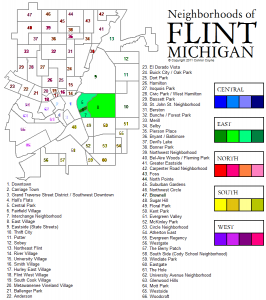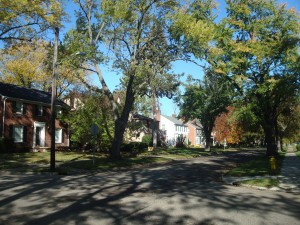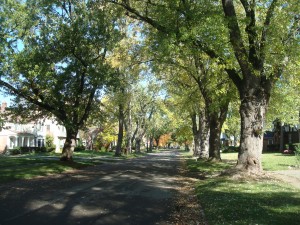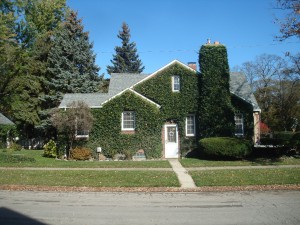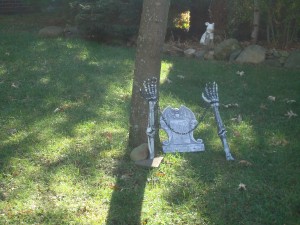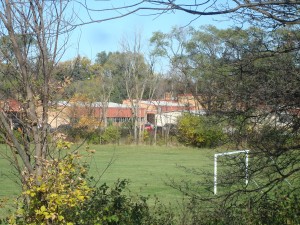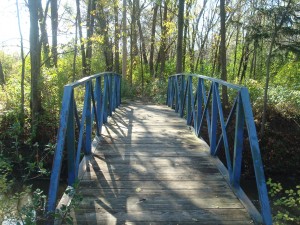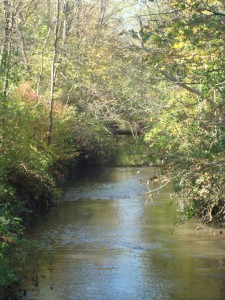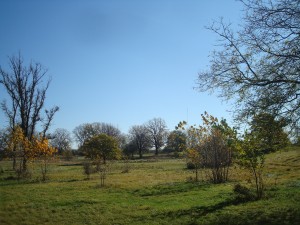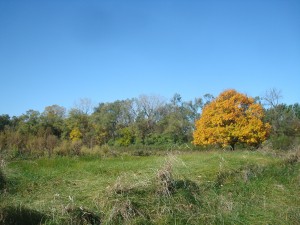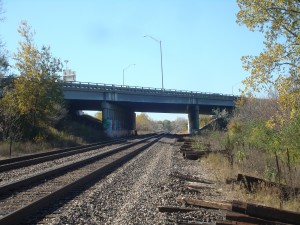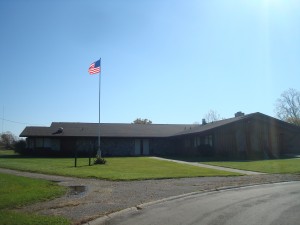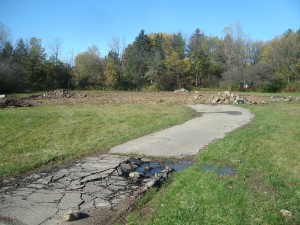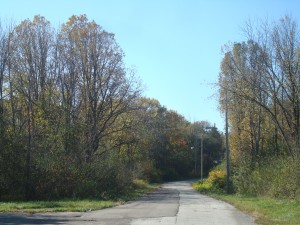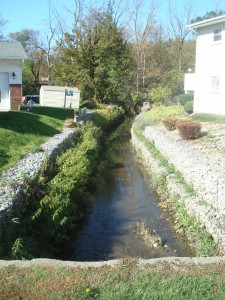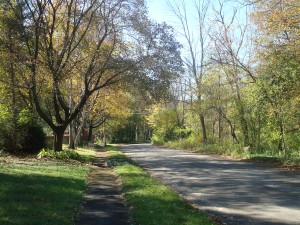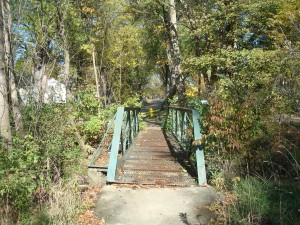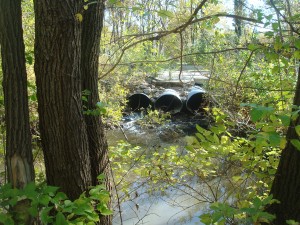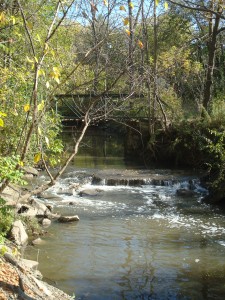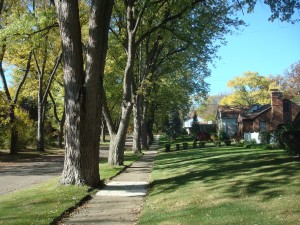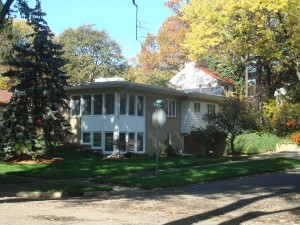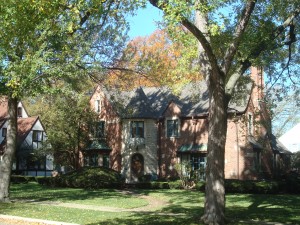For this blog’s relaunch, I wanted to kick off with something fun and colorful. It’s been a great week to explore my neighborhood, as many of the trees — tall maples and oaks — are hitting peak color about now.
I remember a few years ago I was participating in a reading series on Avenue A in Manhattan, and when my bio mentioned that I had grown up “in the East Village of Flint, Michigan” the audience chuckled, as if they were in on an inside joke. If there had been a joke, it would have been on them, since the neighborhood’s name and history are completely independent from the eponymous neighborhood in New York. “East Village” originated in 1976 with the elegiac supposition that Gary Custer’s East Village Magazine printed at 2nd Street and Avon Street, was “east of somewhere, specifically downtown, and following Marshal McLuhan’s ideas that advanced communications had created a ‘global village.'”
This has always been one of Flint’s more storied neighborhoods, and it is increasingly eclectic, economically, culturally, and artistically. I hope that my Flint friends will see this and recognize the uniqueness of what is around them, and that my friends elsewhere will notice the startling beauty of the place I call home.
The actual “name” of the East Village is debated. The area most closely associated with the magazine lies just west of the shuttered Central High School, and is identified by its neighborhood association as being “Central Park.” The area just south of here, in the elbow of I-69 and I-475 is appropriately known as the “Interchange Neighborhood” and includes the Fairfield Village apartments on Court Street and the Richert House public housing high-rise. The larger residential core, which is both to the south and the east of Mott, is typically called the “College Cultural Neighborhood,” particularly south of Court. I do not prefer this term, as it feels contrived to me, and I think that the cosmopolitan connotations of “East Village” play to the neighborhood’s strengths in a more genuine way. But however contentious the terms may be, many residents of these areas identify themselves as “East Villagers,” and there there is general understanding of boundaries as being I-475, I-69, Dort Highway, and Robert T. Longway.
The area is one of the most affluent in the city, which grand stone mansions lining Woodlawn Park Drive. Historically the area has been more urbane and associated with government, education, and civil service than the city’s other affluent pocket of Woodcroft, on the West Side. Woodcroft retains a more corporate, suburban feel today.
Of course, East Village’s affluence has diminished over the years, suffering from the subprime mortgage crisis in addition to the host of other problems plaguing Flint. Many longtime residents have died or moved out as Flint has declined, and the neighborhood has experienced a demographic sea-change. It is now younger, poorer, and more racially diverse than it has been in the past. Although this is a source of anxiety to some, I think that in the long-term it makes the neighborhood more cosmopolitan, and more representative of Flint as a whole, and will allow it to play a more central role in the rejuvenation of the city.
In general, the southern parts of the neighborhood remain the most affluent, especially south of Court between Beard Street and Woodlawn Park. East of Franklin and west of Gilkey Creek, the area is still solidly middle class. In this first installment, I focus on the area south of court and east of Maxine.
An ivy house.
A front yard graveyard; I’m hoping to do a separate album of the neighborhood’s Halloween displays, some of which are memorable.
Pierce Elementary. I took this picture from a distance, because there was an unending recess going on and I didn’t want to be “the guy with the big coat on the sidwalk taking pictures.” Despite their impressive legacy, all of the Flint Community Schools are struggling today, with a 60+% drop in enrollment in the last fifteen years. While Pierce shares in these difficulties, it has a unique program involving a secondary campus in the Flint Cultural Center, where students regularly participate at the library, museums, planetarium, and other institutions.
Gilkey Creek is one of the defining features south of Court. The creek is bridged for motor traffic at three points, and there are three more footbridges. This bridge, near the school, leads to a pleasantly derelict network of footpaths through the wooded parts of Pierce Park.
Gilkey Creek at W. Vernon, looking west.
Pierce Park and Golf Course is one of the largest in the city, being approximately the same size as McKinley Park in Chicago or Fort Tryon Park in New York. Until a few years ago, most of this park was given over to golf. As a kid I remember it being one of the less interesting and accessible parts of the neighborhood. But now that the city has stopped maintaining the park due to budgetary constraints, it has started to go feral again, reverting to the rolling prairie that probably occupied this site 150 years ago.
Walking the perimeter of the park takes over a half hour. In October you’ll see maples and oaks, honeysuckle and cattails, and tall grass. You’ll hear crickets, see butterflies, and the lonely wind is uninterrupted because the park is typically uncrowded. In the distance, across Dort, you can see the remnants of derelict shops and pawn brokers crumbling like primitive mountains. It’s beautiful and peaceful, in a post-apocalyptic sort of way.
The Grand Trunk Railroad and I-69 overpass is one border to the old South Side neighborhoods of Kent Park and Floral Park, which have a tragic history. These neighborhoods had been settled by middle class African Americans since the turn of the century, and became a hot spot for the development of Midwestern Blues music, along similar lines as in Detroit and Chicago. During the Civil Rights era, Flint became the first major city to legislate against racist housing compacts, which plagued the East Village (then known as Woodside) in particular. The installation of I-69 decimated the Kent and Floral Parks, and effectively sealed off the black neighborhoods from the white. Of five Blues club in Kent and Floral Parks, only one, the Golden Leaf Club on Harrison, remains.
Although most of Pierce Park is derelict today, this community center remains open, I believe as a senior center.
A few years ago, this was a tennis court. I put up some pictures of the court mid-decay when I visited for the closing of Central High School in 2009. Evidently the city decided to tear down the remnants after scavengers came and stripped the chain-link fence for scrap.
The western third of Pierce Park is covered in thick forest. From the road it appears to be impenetrable, but from the footbridge over Gilkey Creek, you can access a network of paths.
West of Pierce Park, the East Village becomes residential again, although this area was coterminous with the South Side neighborhood of Kent Park before I-69 went in. Here a neat and well-landscaped drainage ditch runs toward its juncture with Gilkey Creek.
It’s easy to get lost in the little area south of Court, partly because the area is not closely gridded, but just as much due to mapping eccentricities. The two Brookside Drives, straddling Gilkey Creek, are not distinguished from each other by sign or map. Here, the creek runs to the right, while on the left there are sprawling ranch-style houses on huge, wooded lots.
The second of the thee footbridges over Gilkey Creek is at Kensington.
A draintage ditch empties into Gilkey Creek.
Small rapids under the footbridge.
Linwood used to be an affluent street in the East Village. As in Detroit, a large part of the key to the city’s resurgence may lie in its recent and relative cheapness. In a time when many across the country are unable to afford their mortgage payments (including a lot of people in Flint), these mansions are owned by teachers, nurses, and other middle-class professionals. When the city does rebound, the East Village will be one of the quickest neighborhoods to recover, and those who have taken a risk on purchases here will be richly rewarded.
The East Village is architecturally eclectic. The houses on Linwood and Blanchard street are typically traditional designs: Georgians, Cape Cods, or perhaps Neo-Gothic in design. But there are several striking examples of Prairie-style houses.
In my novel, a few of my characters lived in one of the big old houses on Linwood. They lived lives of Midwestern decadence, although that is atypical of this neighborhood these days.
The next installment (coming soon!) will take in Mott Community College and the part of the East Village north of Court.
UPDATE: The second installment has been posted here. The third installment has been posted here.
